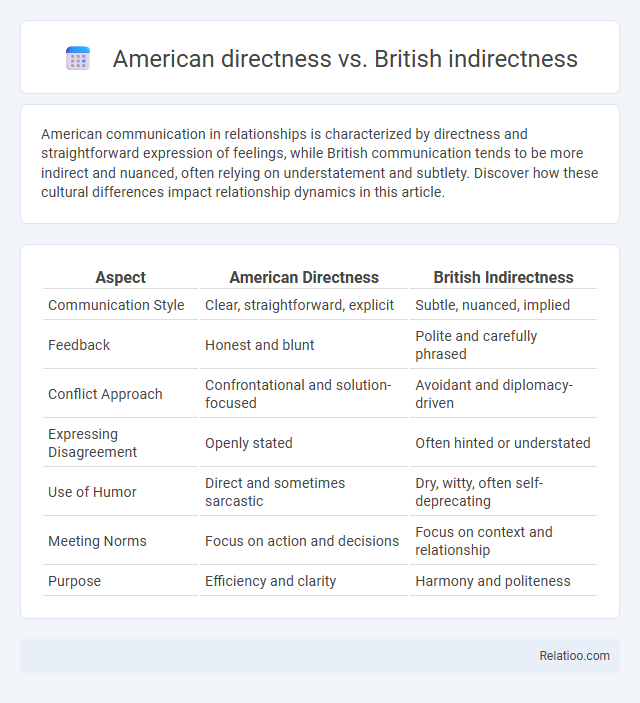American communication in relationships is characterized by directness and straightforward expression of feelings, while British communication tends to be more indirect and nuanced, often relying on understatement and subtlety. Discover how these cultural differences impact relationship dynamics in this article.
Table of Comparison
| Aspect | American Directness | British Indirectness |
|---|---|---|
| Communication Style | Clear, straightforward, explicit | Subtle, nuanced, implied |
| Feedback | Honest and blunt | Polite and carefully phrased |
| Conflict Approach | Confrontational and solution-focused | Avoidant and diplomacy-driven |
| Expressing Disagreement | Openly stated | Often hinted or understated |
| Use of Humor | Direct and sometimes sarcastic | Dry, witty, often self-deprecating |
| Meeting Norms | Focus on action and decisions | Focus on context and relationship |
| Purpose | Efficiency and clarity | Harmony and politeness |
Understanding American Directness
American directness emphasizes clear, straightforward communication, valuing efficiency and transparency in interactions. Understanding American directness helps you interpret intentions without reading between the lines, as speakers prioritize honesty and brevity over subtlety. This style contrasts with British indirectness, where politeness and nuance often mask true meanings to maintain social harmony.
Exploring British Indirectness
British indirectness often involves subtlety, understatement, and reliance on context to convey meaning, contrasting with the more explicit American directness and general direct communication styles. Phrases like "perhaps we could consider" or "it might be better if" exemplify this preference for polite, nuanced expression that avoids confrontation. This indirect approach fosters social harmony and reflects cultural values emphasizing politeness and restraint.
Historical Roots of Communication Styles
American directness in communication stems from the country's frontier history and individualistic culture, emphasizing clarity and efficiency rooted in practical needs for swift decision-making. British indirectness reflects historical class structures and a cultural preference for politeness and understatement to maintain social harmony and avoid confrontation. These differing styles highlight how historical contexts have shaped communication approaches, with American directness prioritizing transparency and British indirectness valuing subtlety and nuance.
Cultural Values Shaping Language
American directness reflects cultural values of clarity, efficiency, and individualism, emphasizing straightforward communication to achieve goals. British indirectness, rooted in politeness, social harmony, and respect, often employs understatement and euphemism to navigate sensitive topics subtly. Your understanding of these differences enhances cross-cultural interactions by recognizing how cultural values fundamentally shape language and communication styles.
Common Expressions: Direct vs Indirect
American communication frequently employs direct expressions such as "Tell me what you want" or "Get to the point," reflecting a cultural preference for clarity and efficiency. In contrast, British speakers often use indirect phrases like "Perhaps you could let me know your thoughts" or "If you don't mind, could you clarify," which soften requests to maintain politeness and social harmony. Understanding these common expressions is crucial for effective cross-cultural dialogue, as direct communication values straightforwardness, while indirect communication emphasizes nuance and relationship preservation.
Navigating Social Situations
American communication often emphasizes directness, prioritizing clarity and straightforward expression to efficiently navigate social situations. In contrast, British communication tends to favor indirectness, using subtlety and politeness to maintain harmony and avoid confrontation. Understanding these cultural differences in communication styles is essential for effective interpersonal interactions and avoiding misunderstandings in diverse social contexts.
Workplace Communication Contrasts
American directness in workplace communication emphasizes clear, concise language that prioritizes efficiency and straightforward feedback, enhancing decision-making speed. British indirectness often employs politeness and subtlety, using nuanced language to maintain harmony and avoid confrontation, which can influence team dynamics and conflict resolution. Your communication style should adapt to these cultural contrasts for effective collaboration in diverse professional environments.
Misunderstandings and Stereotypes
American directness often leads to clear communication but can be perceived as blunt or rude by those accustomed to British indirectness, which values politeness and subtlety. British indirectness may cause misunderstandings for Americans, who might view it as evasive or vague, while stereotypes about directness and indirectness fuel misinterpretations on both sides. Your ability to navigate these communication styles can reduce stereotypes and prevent common misunderstandings rooted in differing cultural expectations.
Tips for Effective Cross-Cultural Communication
Mastering effective cross-cultural communication requires understanding American directness, which values clear, straightforward language, and British indirectness, characterized by subtlety and understatement. Tailoring your approach by reading contextual cues and adapting your tone helps bridge communication gaps, ensuring Your message resonates appropriately across cultures. Utilize active listening and ask clarifying questions to navigate different conversational styles and avoid misunderstandings.
Embracing Diversity in Conversation
American directness emphasizes clear, concise messages that prioritize efficiency and transparency, fostering straightforward understanding. British indirectness often relies on subtlety, politeness, and context to convey meaning, encouraging nuanced interpretation and social harmony. Embracing diversity in conversation involves recognizing and respecting these communication styles, enhancing cross-cultural dialogue by adapting to different preferences for direct or indirect expression.

Infographic: American directness vs British indirectness
 relatioo.com
relatioo.com